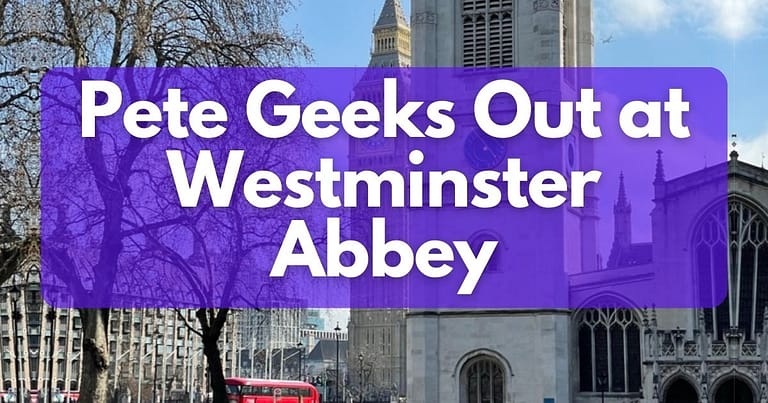SUMMARY:
Pete recently returned from a trip to London and he reflects on the differences in how Americans and Europeans think. Pete observed that Europeans are more knowledgeable about history because it literally surrounds them in a way that it does not in the United States. He suggested that this could be one of the reasons for the difference in how Americans and Europeans think.
This conversation is about the need for Americans to work harder to gain a deeper understanding of human existence on this planet. Students needs to look at history, science, and art in a different light in order to gain a more meaningful understanding.
TRANSCRIPT:
0:00:03 Hi, everyone. It’s Pete from Achieve Tutorials, just back from a trip to London. But before we get to that, if you haven’t yet, please click the link below to subscribe or follow us.
My London trip got me pondering about the way we think in America and the way Europeans think, and maybe one reason why there’s a difference. When I visit Europe or I talk to my European friends, I often think about a stand up comedy routine that Eddie Izzard does.
0:00:29 In one bit, Izzard challenges his American audience on their understanding of American history. It’s quite funny, but it also points to a truth that often Americans are less knowledgeable about European and even American history than our neighbors from across the pond. And one reason that I’ve noticed this is true: history literally surrounds Europeans in a way that simply isn’t possible here in the United States.
0:00:57 It’s not just limited to names and dates and historical understanding, but to literature, to science, to the arts. There are constant reminders in Europe wherever you look. I was quite literally geeking out in Westminster Abbey, the church where coronations and royal weddings occur.
0:01:13 Hey, guys, it’s Pete. I am standing in front of Westminster Abbey, which is a pretty remarkable place. I’m not allowed to shoot video inside, but I did take some photos, which I’m going to share with you in a minute.
0:01:25 There are so many historical figures buried or memorialized in Westminster Abbey that you quite literally can’t avoid standing on some of their graves. Here are the Goliaths of literature: Jeffrey Chaucer, Charles Dickens, Henry James, George Elliott, Thomas Hardy, Rudyard Kipling, Ben Johnson…incidentally, the only person buried upright in the cathedral. There’s Jane Austin, William Wordsworth, Alfred Lord Tennyson, and Charlotte, Emily, and Anne Bronte. There’s a large memorial to William Shakespeare.
0:01:54 Samuel Johnson, author of the authoritative dictionary of the English Language, is here. There are musicians such as George Frederick Handel, Henry Purcell, and playwright and composer Noel Coward. Even actor Lawrence Olivier is buried there. And then there are historical figures like David Livingston, Admiral Arthur Phillip—the founder of modern Australia according to his stone—and a veritable who’s who of English kings and queens, 30 and all, including James I, Henry’s three, five and seven.
0:02:21 Nelson Mandela has a memorial stone right in the center of the cathedral. Men of science, some of whom, ironically, were atheists and fed skepticism in the church and its teachings are buried there. Charles Darwin, the father of the theory of evolution, Sir Isaac Newton, Michael Faraday, Ernest Rutherford of the Rutherford gold foil experiments, and Stephen Hawking, a self proclaimed atheist buried in the most famous church in the United Kingdom. But perhaps my favorite, and I totally geeked out on this one, is John Harrison, a clockmaker who showed up the world’s greatest scientists by creating a clock that could keep accurate time in adverse conditions on ships around the world.
0:03:02 It allowed navigators to finally calculate their longitude with precision and literally saved thousands or tens of thousands of lives that would have been otherwise lost to shipwrecks. His invention used different types of metals to offset the expansion and contraction caused by changes in temperature, and his memorial stone reflects this with a longitude line made of two different types of metals.
0:03:25 Man, that is just cool. So be still, my beating heart. What’s my point? That we Americans are not surrounded by the same depth of history on a daily basis. Only on the East Coast do we get even some sort of a semblance of the kind of historical surroundings and the historical presence that they get in Europe on a daily basis. So to benefit from a deep seated understanding of human existence on this planet, we need to work harder.
0:03:54 We need to look at history and science and art in a different light, in an inspiring light. Put yourself in the world that these people lived in and poke around a bit. A friend of mine once told me that we need to take people and ideas and objects and turn them around in order to start to understand the different perspectives in which they existed. And only then can we begin to have a deeper understanding.
0:04:22 All right, enough rambling. Get out there and have a curious day and poke around a bit. Thank you, and I’ll see you next time. Thank you for listening. And if you haven’t yet, please subscribe to our YouTube channel or follow of us on Instagram. And if you have any questions or comments, please feel free to contact us through our website achievetutorials.com.






